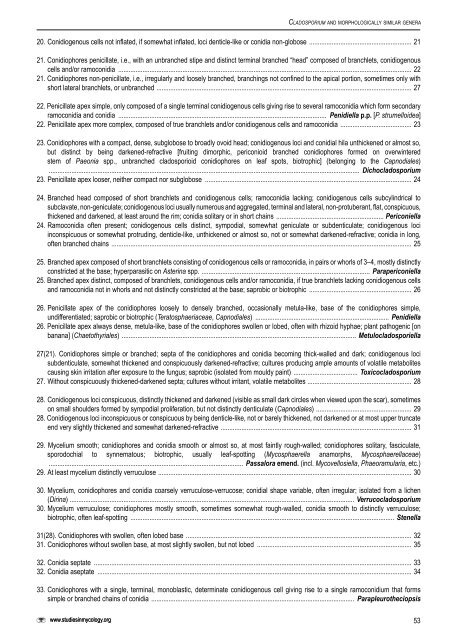The genus Cladosporium and similar dematiaceous ... - CBS - KNAW
The genus Cladosporium and similar dematiaceous ... - CBS - KNAW
The genus Cladosporium and similar dematiaceous ... - CBS - KNAW
Create successful ePaper yourself
Turn your PDF publications into a flip-book with our unique Google optimized e-Paper software.
<strong>Cladosporium</strong> <strong>and</strong> morphologically <strong>similar</strong> genera<br />
20. Conidiogenous cells not inflated, if somewhat inflated, loci denticle-like or conidia non-globose ............................................................ 21<br />
21. Conidiophores penicillate, i.e., with an unbranched stipe <strong>and</strong> distinct terminal branched “head” composed of branchlets, conidiogenous<br />
cells <strong>and</strong>/or ramoconidia .......................................................................................................................................................................... 22<br />
21. Conidiophores non-penicillate, i.e., irregularly <strong>and</strong> loosely branched, branchings not confined to the apical portion, sometimes only with<br />
short lateral branchlets, or unbranched ................................................................................................................................................... 27<br />
22. Penicillate apex simple, only composed of a single terminal conidiogenous cells giving rise to several ramoconidia which form secondary<br />
ramoconidia <strong>and</strong> conidia ......................................................................................................................... Penidiella p.p. [P. strumelloidea]<br />
22. Penicillate apex more complex, composed of true branchlets <strong>and</strong>/or conidiogenous cells <strong>and</strong> ramoconidia .......................................... 23<br />
23. Conidiophores with a compact, dense, subglobose to broadly ovoid head; conidiogenous loci <strong>and</strong> conidial hila unthickened or almost so,<br />
but distinct by being darkened-refractive [fruiting dimorphic, periconioid branched conidiophores formed on overwintered<br />
stem of Paeonia spp., unbranched cladosporioid conidiophores on leaf spots, biotrophic] (belonging to the Capnodiales)<br />
.................................................................................................................................................................................... Dichocladosporium<br />
23. Penicillate apex looser, neither compact nor subglobose ........................................................................................................................ 24<br />
24. Branched head composed of short branchlets <strong>and</strong> conidiogenous cells; ramoconidia lacking; conidiogenous cells subcylindrical to<br />
subclavate, non-geniculate; conidiogenous loci usually numerous <strong>and</strong> aggregated, terminal <strong>and</strong> lateral, non-protuberant, flat, conspicuous,<br />
thickened <strong>and</strong> darkened, at least around the rim; conidia solitary or in short chains ............................................................... Periconiella<br />
24. Ramoconidia often present; conidiogenous cells distinct, sympodial, somewhat geniculate or subdenticulate; conidiogenous loci<br />
inconspicuous or somewhat protruding, denticle-like, unthickened or almost so, not or somewhat darkened-refractive; conidia in long,<br />
often branched chains ............................................................................................................................................................................. 25<br />
25. Branched apex composed of short branchlets consisting of conidiogenous cells or ramoconidia, in pairs or whorls of 3–4, mostly distinctly<br />
constricted at the base; hyperparasitic on Asterina spp. ................................................................................................. Parapericoniella<br />
25. Branched apex distinct, composed of branchlets, conidiogenous cells <strong>and</strong>/or ramoconidia, if true branchlets lacking conidiogenous cells<br />
<strong>and</strong> ramoconidia not in whorls <strong>and</strong> not distinctly constricted at the base; saprobic or biotrophic ............................................................ 26<br />
26. Penicillate apex of the conidiophores loosely to densely branched, occasionally metula-like, base of the conidiophores simple,<br />
undifferentiated; saprobic or biotrophic (Teratosphaeriaceae, Capnodiales) .............................................................................. Penidiella<br />
26. Penicillate apex always dense, metula-like, base of the conidiophores swollen or lobed, often with rhizoid hyphae; plant pathogenic [on<br />
banana] (Chaetothyriales) ........................................................................................................................................ Metulocladosporiella<br />
27(21). Conidiophores simple or branched; septa of the conidiophores <strong>and</strong> conidia becoming thick-walled <strong>and</strong> dark; conidiogenous loci<br />
subdenticulate, somewhat thickened <strong>and</strong> conspicuously darkened-refractive; cultures producing ample amounts of volatile metabolites<br />
causing skin irritation after exposure to the fungus; saprobic (isolated from mouldy paint) ...................................... Toxicocladosporium<br />
27. Without conspicuously thickened-darkened septa; cultures without irritant, volatile metabolites ............................................................ 28<br />
28. Conidiogenous loci conspicuous, distinctly thickened <strong>and</strong> darkened (visible as small dark circles when viewed upon the scar), sometimes<br />
on small shoulders formed by sympodial proliferation, but not distinctly denticulate (Capnodiales) ....................................................... 29<br />
28. Conidiogenous loci inconspicuous or conspicuous by being denticle-like, not or barely thickened, not darkened or at most upper truncate<br />
end very slightly thickened <strong>and</strong> somewhat darkened-refractive .............................................................................................................. 31<br />
29. Mycelium smooth; conidiophores <strong>and</strong> conidia smooth or almost so, at most faintly rough-walled; conidiophores solitary, fasciculate,<br />
sporodochial to synnematous; biotrophic, usually leaf-spotting (Mycosphaerella anamorphs, Mycosphaerellaceae)<br />
................................................................................................................. Passalora emend. (incl. Mycovellosiella, Phaeoramularia, etc.)<br />
29. At least mycelium distinctly verruculose .................................................................................................................................................. 30<br />
30. Mycelium, conidiophores <strong>and</strong> conidia coarsely verruculose-verrucose; conidial shape variable, often irregular; isolated from a lichen<br />
(Dirina) .................................................................................................................................................................... Verrucocladosporium<br />
30. Mycelium verruculose; conidiophores mostly smooth, sometimes somewhat rough-walled, conidia smooth to distinctly verruculose;<br />
biotrophic, often leaf-spotting ......................................................................................................................................................... Stenella<br />
31(28). Conidiophores with swollen, often lobed base ................................................................................................................................... 32<br />
31. Conidiophores without swollen base, at most slightly swollen, but not lobed .......................................................................................... 35<br />
32. Conidia septate ........................................................................................................................................................................................ 33<br />
32. Conidia aseptate ...................................................................................................................................................................................... 34<br />
33. Conidiophores with a single, terminal, monoblastic, determinate conidiogenous cell giving rise to a single ramoconidium that forms<br />
simple or branched chains of conidia ...................................................................................................................... Parapleurotheciopsis<br />
www.studiesinmycology.org<br />
53

















